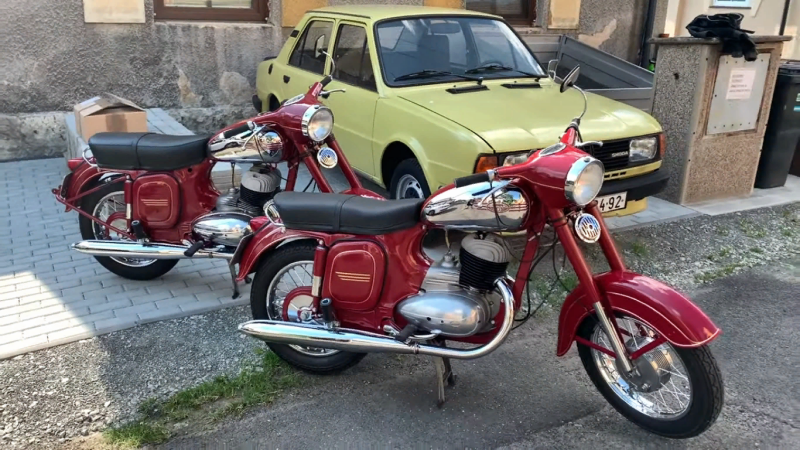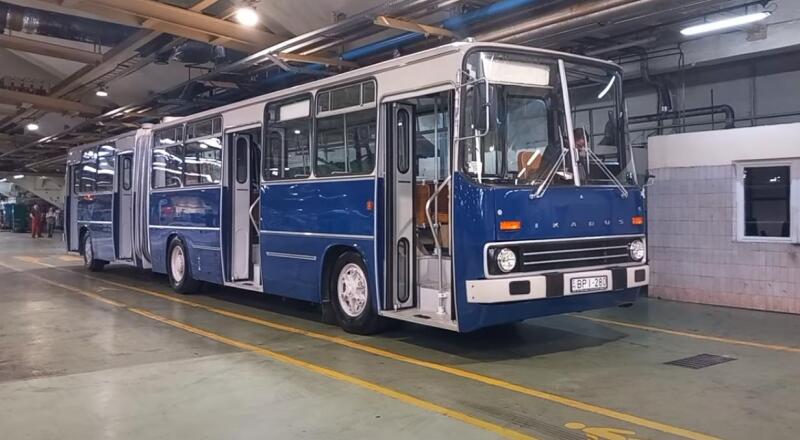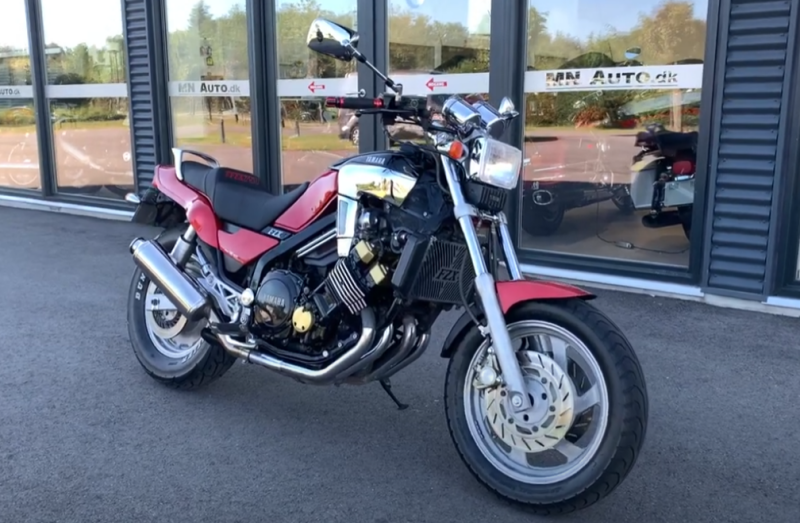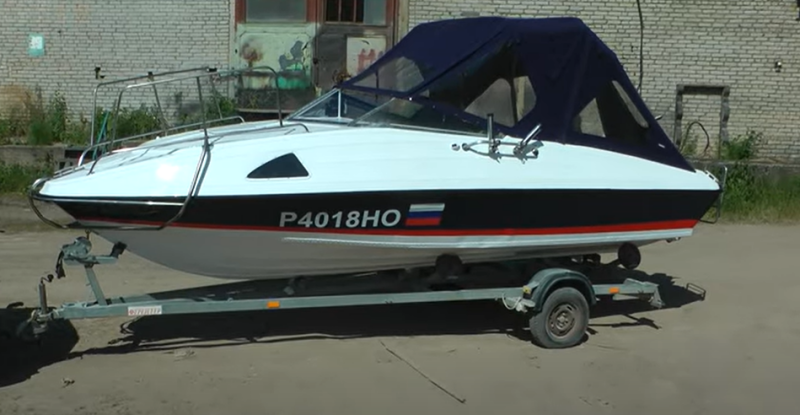At that time, the joint Jawa-CZ brand produced and sold a number of models in the main classes: 125, 175, 250 and 350 cc. cm. They were in demand both in Czechoslovakia itself and in many neighboring countries. They are still relatively easy to find. These are the famous Kyvacky.
 Excellent equipment for its time Jawa 250/559. Photo: youtube.com
Excellent equipment for its time Jawa 250/559. Photo: youtube.comTrue, the most massive export in the history of the plant to the huge Soviet market had not yet begun. In 1960, those at the top realized that the decision to merge the two enterprises was wrong. After all, two well-known motorcycle brands for such a fairly small country are much better than one. Again, there is also competition, which encourages us to move forward and overtake each other.
The separation clearly benefited both
Thus, in the new decade, separate Czechoslovak brands CZ and Jawa reappeared. And, indeed, the division of production had a very positive impact on both enterprises. While the former soon became firmly established in the sports niche (especially motocross), the main manufacturer of equipment in the country offered a number of good road models.
Developments in Tyniec move forward, and in 1962 the plant introduces a completely new type. This is a machine marked Jawa 250/559/02. Later, users confirmed its popularity by giving the motorcycle a personal nickname – Panelka.
The Czechs managed to work on the design and performance. This was a seriously modernized version of the previous type 353 “Kivachka”, which (in comparison) received several external differences:
✅ straight saddle replaces the original “guitar” shape
✅ factory gearbox instead of “Bosch”
✅ headlight in the upper part, covered with a shield
The latter element also partially covered the driver while driving. The top headlight cover extended from the solid (undivided) steering wheel to the handles. But even more new things awaited the user in other design elements. For example, an improved power unit. At the end of 1964, type 250/559/04 began to be produced with a number of other improvements, affecting:
✅ engine air damper
✅ clutch
✅ rear wheel supports
It now consisted of rubber blocks that absorbed the impacts of the wheels. The engine was equipped with an air damper controlled by a cable from the steering wheel of the vehicle. Type 250/559/03 and 350/360/01 were produced simultaneously. These motorcycles had an automatic clutch and are quite rare today.
Many modifications to the basic bike
Other options were 250/559/06 and 350/360/02 with alternator and rectifier. Type 250/559/07 was equipped with a carburetor without a choke, and 350/360/03 was intended for the military. However, from the memories of those years it follows that ordinary red cars with chrome were also supplied to the compounds. There they were repainted khaki with their own efforts.
 Large wing Jawa 250/559, could have been smaller. Photo: youtube.com
Large wing Jawa 250/559, could have been smaller. Photo: youtube.comThe 250/559/04/08 modification with dual steering was considered a purely training vehicle. Therefore, it was supplied exclusively to driving schools. Although the world of racing equipment was increasingly dominated by “Chezet” competitors, it cannot be said that Jawa did not produce similar versions at all. Another option for the machines in this series are the “sports” types. They are labeled Jawa 250/590 (1965-1970) and 350/361 (1965-1969).
Let's take a closer look at one of the most interesting versions of this motorcycle. In 1963, the Jawa 250 type 559/03 appeared with an automatic centrifugal clutch - an original design solution from the plant. It was mounted on the main shaft of the gearbox, operating in oil and having a multi-lamella design.
In addition to automatic clutch and decoupling of the driving and driven parts, it was also equipped with manual control and semi-automatic shutdown associated with the gear lever. Therefore, to drive it, all that was needed was a rotating gas handle, a gearshift lever and brakes. When starting off, it was enough to add speed and the motorcycle began to move smoothly. During a stop, the clutch was automatically disengaged and the engine idled.
 Jawa 250/559 engine with a volume of 250 cc. Photo: youtube.com
Jawa 250/559 engine with a volume of 250 cc. Photo: youtube.comIt also allowed the car to be pushed and was slightly more expensive than the regular model. Thanks to the quick response to throttle application and the wing configuration, the bike had a special sporty atmosphere. Later, the clutch received an improvement aimed at preventing slipping during sudden engagement.
Technical features of the “Panel”
The Jawa 250/559 boasted a new tachometer coupled with FAB switch box and lighting control system. The rear combination lamp was made of hardened plastic and had a rectangular shape. The seat was lockable and the side drawers could only be opened by lifting it up.
The flushing ports, which were previously located in the engine housing, were now located in a redesigned cylinder. The carburetor neck in them was directed towards the latter, and not towards the engine housing, as in older types. The motorcycle also received a choke, the exhaust pipe was secured with a much smaller nut with internal threads inside the structure.
 New type speedometer for Jawa 250/559. Photo: youtube.com
New type speedometer for Jawa 250/559. Photo: youtube.comThe first series of type 559 had a crankshaft, initially installed only with two bearings, but later this turned out to be unprofitable. Therefore, from 1965, production returned to the original solution with three bearings in the design. A rubber shock absorber socket in the rear wheel hub has increased the service life of the unit, and the front telescopic fork has also undergone changes.
The 250 was equipped with a holder for a small PAV luggage trailer. It was suspended behind the rear wheel on a special movable hinge in the original frame mounted on the motorcycle. Here are some indicators of Jawa 250/559:
✅ frame – welded, made of square profiles
✅ wheelbase - 1335 mm
✅ dry (finished) weight – 128 (140) kg
✅ dimensions – 1980 x 650 x 1025 mm
✅ maximum speed - 110 km / h
The intake system, including the air filter insert, has been redesigned and simplified through the use of Jikov carburetors of a different design. With a diffuser diameter of 26mm, some models featured a magnetic dynamo, while others had no air dam at all. Previous types had a crank mechanism housed in three bearings: one on the right side of the engine and two on the left of the primary chain. Here are the characteristics of the power unit:
✅ Gearbox – four-speed, chain drive
✅ working volume - 249 cubic meters. cm
✅ power – 14 l. s (10,3 kW) at 5000 rpm
✅ compression ratio – 7,7:1
✅ fuel consumption - 3,7 l / 100 km
✅ tank capacity - 13,5 l
This Czechoslovakian motorcycle turned out to be a real long-liver, having stood on the assembly line for about 12 years. The most popular modification was the Jawa 250/559/04, which was produced from 1964 to 1974. On the contrary, the sports version of the 250 cc motorcycle (1963-1964) was assembled very little.
 Jawa 250/559 seat, no longer a “guitar”. Photo: youtube.com
Jawa 250/559 seat, no longer a “guitar”. Photo: youtube.comJawa 250/559 was lucky with the timing of its release into series. It was then that the export of Czech equipment to the Soviet Union began and the company’s business went sharply uphill. The model opened the way for new motorcycles from a brand still popular among us, which pleased many young people in the USSR and other countries with their excellent driving performance.










